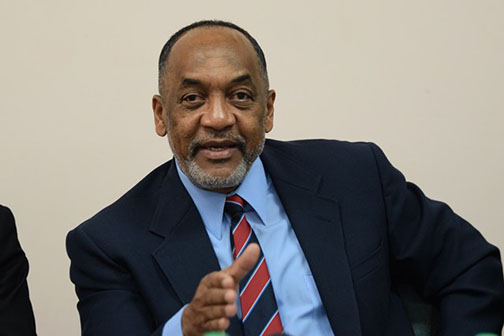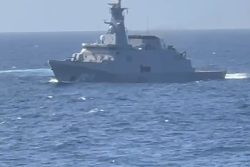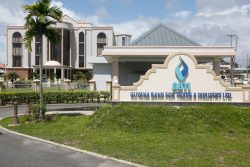A clause in government’s environmental permit for the upcoming Payara Well may give ExxonMobil carte blanche to flare continuously for free thus dimming any hope of Guyana collecting on the US$30 per tonne of carbon dioxide equivalent (CO2 eq) fine it has imposed for flaring over 60 days, former EPA Director Dr. Vincent Adams says.
Aside from there being no provision to stop the flaring after 60 days, Adams said that urgent revision is needed of clause 3.4 of the Payara Permit which he believes negates the US$30 penalty for flaring after that period.
According to Clause 3.4 of the Payara Permitm which is now the template for all such current and future permits, “Flaring is only permissible under the following conditions: Commissioning, Start-up, or Special Circumstances.”
Covered under “Special Circumstances”, is “Planned/unplanned maintenance and inspection on gas handling equipment and related processes” and Adams argues that is where problems could arise in the future.
“Since all of the flaring could only be caused by the gas handling equipment, and since by this definition, flaring is allowed whenever the gas handling equipment is under maintenance; then, it could only be concluded that the insertion of this Clause is nothing but a farce and a slick gimmick to legalize all flaring occurring before and after 60 days, at the expense of our people’s health and environment,” Adams told Stabroek News.
He said that as he was analyzing the permit he was shocked to see the modifications from the permit started under him and which had more rigid adherence rules for the oil major. He said that the language used in the clause possibly passed unnoticed since only some people would understand that it is from the gas handling equipment that flaring comes from.
“The flaws in this permit modification are astonishing, and do not appear to be just a coincidence that they are all extremely favourable to EEPGL (ExxonMobil’s local subsidiary),” he said.
A review of the Payara Field Development Plan and environmental issues had been done by Canadian Queen’s Counsel Alison Redford after the PPP/C entered office last year August.
The Petroleum Production Licence states that routine flaring of gas by the Licensee is strictly prohibited without approval. It adds that flaring is only permissible under the following conditions defined in the Licensee’s Environmental Permit: (a) Commissioning and Start-up: the Licensee shall not exceed sixty (60) days of flaring during Start-up; and (b) Special circumstances, including: 1) Emergencies; ii) Maintenance; iii) Restart, or as allowed under the Environmental Permit or approved by the Environmental Protection Agency.
Adams said that the modifications must be of concern to citizens and he again criticised having the company paying a fine saying it “ostensibly means that flaring could continue unabated forever”, as long as the minuscule fine of $30 per tonne of carbon dioxide equivalent (CO2 eq) is being paid.
ExxonMobil had earlier this month said that with the repairs to components of the Liza Destiny oil platform flash gas compressor completed, it hoped that by the middle of this month the reinstallation and start-up of the compressor would be done. The US oil major has said that even though it would repair the faulty compressor, it still planned to install a new design in November of this year.
Status
But up to yesterday there had been no update on the status of the fix and the company continued to flare around 15MMcf of associated gases per day. There are fears that Exxon is not on top of the Liza Destiny flaring problems and this could set the trend for operations at the upcoming Liza-1 and Payara wells.
Vice President Bharrat Jagdeo has said that the company would have begun paying for the flaring of its estimated 15 million cubic feet (MMcf) per day of associated gases from the Liza-1 well from May 26th last. This is because the 36 days applied for had expired.
According to Jagdeo the total accrued in fines for the period under the revised Environmental Permit would be around US$1.3 million.
It is unclear how the monies would be paid and if any has to date been collected.
And on its determination of the $30 per tonne fine that Guyana says is an international standard and under the Polluter Pays Principle (PPP), Adams said that research has exposed the fact that the internationally accepted numbers are more in the range of $60 to $100 per tonne and this country also did not understand when the PPP is used.
“Regardless though, the only problem, whether by sheer carelessness or ineptitude, is that Clause 3.4 of the Payara Permit negates any such penalties for flaring, no matter the time period and amount”, Adams said
The former Environmental Protection Agency (EPA) Director, who was fired by the PPP/C government last year, contends that according to the Polluter Pays Principle, a sum is calculated for pollution or a cleanup exercise for an oil spill and not for planned pollution.
Of the current guidelines for ExxonMobil, he said “the polluter is allowed to pollute as much as they want and for as long as they want, as long as they pay the paltry $30 per tonne of CO2 eq for it – a bizarre interpretation, since all environmental principles are designed to curb pollution and not to incentivize it. Such a low fee would certainly be an incentive for unlimited flaring if it costs the company less to pay the fines when compared to purchasing, running and maintaining the gas handling equipment causing the flaring.”
“It is also evident why, because of this strange interpretation, the modification has no stated condition for terminating flaring after the 60 days, as long as EEPGL pays for the flaring, notwithstanding the fact that Clause 3.4 of the Payara Permit unquestionably appears to exempt all flaring from fines and penalties, regardless of time period and amounts”.
For “government’s edification”, Adams explains, “the “Polluter Pays Principle” was created with the simple intent to make the polluter pay for clean-up of damage to the environment after an incident or operation such as an oil spill. It would be contradictory and even counter intuitive to the definition and spirit of environmental protection to think that it could have meant freedom to pollute as much as you can and for long as you can, as long as you pay for it.”
Wading into both the EPA and the government, Adams said that action must be taken now to address the loopholes in the permit and said that any reference to the 14 billion cubic feet (BCF) of gas in the Environmental Impact Assessment for the Liza-1 well must be stopped lest it confuses the public into believing there is an allowance total granted.
“The weird inclusion of this publicly validated mistruth coming from a government agency that people are supposed to trust, could only be construed as a bare-faced slick move to codify its dumbfounding legalization of the 14 bcf of gas illegally flared to date, so as to inoculate this amount from the $30 per tonne penalty,” Adams said.
“If the Government cares to be taken seriously on this matter by the people of Guyana and by the people watching this situation from around the world, then it must not continue to defend this egregious flaring against its own laws for which it took an oath to protect. Instead, it must start with levying the $30 per tonne fine, as measly as it may be, against the existing illegally flared 14 bcf of gas,” he added.







